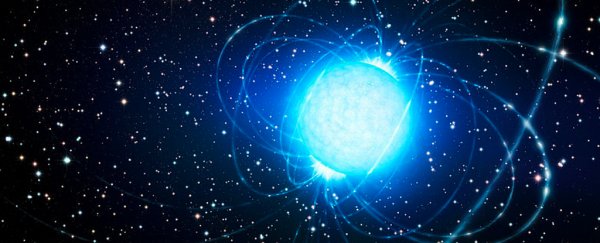After more than a decade of patiently waiting and watching, astronomers have seen signs that one of the rarest stars known to science is waking up from its slumber.
It's called XTE J1810–197, and it's part of an exclusive club of weird stars – it's one of just four highly magnetic magnetars that have been found to emit radio waves.
At least it did, until a decade ago when those radio waves went quiet. Now it's stirring again, and astronomers have their telescopes at the ready to record.
That might not sound that exciting, but magnetars themselves are incredibly weird. They're essentially 'dead' stars that, for reasons we don't fully understand, have insanely powerful magnetic fields.
To put it into perspective these incredibly dense, collapsed stars can generate magnetic fields that are around 1 quadrillion times more powerful than Earth's. So, yeah, they're odd.
We currently know of 23 magnetars, but XTE J1810–197 is something else entirely. While magnetars all blast out high energy stuff, XTE J1810–197 and only three other stars we've found pulse out radio waves.
And then, in late 2008, its radio waves suddenly went quiet, and stayed that way.
Until now.
Since December 8 last year, researchers from the University of Manchester and Max-Planck-Institut fur Radioastronomie have been monitoring a fresh stream of radio emissions from the most unusual cosmic object.
Interestingly, the profile of this new rhythm of radio waves shows some pretty big differences since they were first noticed all those years ago.
"The pulse variations seen so far from the source have been significantly less dramatic, on timescales from hours to months, than seen in 2006," the research team report.
Among them are tiny ripples of activity on a millisecond scale that might be caused by tiny shivers in the star's crust.
The thing is we still don't know a lot about magnetars. They seem to form in the same way as your average neutron star, starting with the collapsing core of a massive, dying star squeezing atoms so their nuclei are pressed butt-to-cheek.
At some point the compact body starts to generate magnetic fields in the order of around 10^15 gauss. By comparison, a typical fridge magnet is around 50 gauss, which is still 100 times stronger than our planet's magnetic field at the surface.
What causes such powerful magnetism is a mystery, with most theories suggesting it could all start with the neutron star spinning at hundreds to thousands of times per second and turning into a pulsar.
Think of a bunch of suns crammed into a space the size of a small city whipping around with the ferocity of a helicopter's blades and you can begin to imagine these monsters.
If that's not intense enough, since their prediction in the late 80s, magnetars have become associated with strange, irregular bursts of gamma and X-ray radiation that repeat in some parts of the sky.
The going explanation for these massive outbursts of powerful radiation is adjustments in the star's neutron-packed crust – the magnetar equivalent of an earthquake – tug its magnetic field into new alignments.
The weird thing about XTE J1810–197 is a year after it briefly shone in X-rays back in 2003, astronomers noticed it was sighing in pulses of far gentler radio waves. Initial observations noticed it was spitting out low energy electromagnetic radiation once a turn, about every five and a half seconds.
It was the first of just a handful of radio-emitting magnetars that have since been discovered.
This exclusive class of star blurs the lines between these magnetic monsters and garden variety pulsars, their own weaker magnetic fields channelling beams of radiation that glow in radio waves that sweep across the cosmos as they spin.
Maybe all magnetars produce radio waves in similar ways and we only see them in a few? Perhaps there's something special about XTE J1810–197 and the other three radio-emitting magnetars?
Going on this new study, it's possible that tremors in the star's crust of packed neutrons not only realign its powerful magnetic field, but directly contribute to a range of electromagnetic frequencies that include radio waves.
The research is currently available on the pre-review site, arxiv.org, so it's set to generate some discussion.
Another teams of astronomers recently used NASA's Deep Space Network to check out XTE J1810–197 and two of its radio magnetar cousins. They also happened to notice some odd variations in the radio wave emissions.
Future observations might help whittle away speculations on what's behind these pulses, and why they come and go as they do.
Now that one of the beasts is awake again, it might yet have more to say on the matter.
